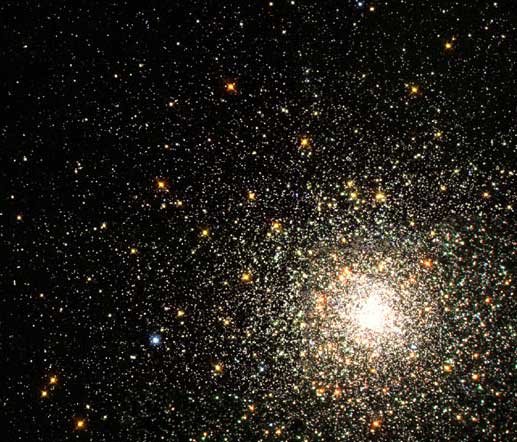Credit & Copyright: F. R. Ferraro
(ESO
/Bologna Obs.),
M. Shara
(STSci
/AMNH) et al.,
& the Hubble Heritage Team (AURA/ STScI/ NASA)
Explanation:
If our Sun were part of M80, the
night sky would glow like a
jewel box of bright stars.
M80, also known as NGC 6093, is one of about 250
globular clusters that survive in our Galaxy.
Most of the stars in
M80 are older and redder than our
Sun,
but some enigmatic stars appear to be bluer and younger.
Young stars would contradict the hypothesis that
all the stars in
M80 formed at nearly the same time.
These unusual stars are known as
blue stragglers, and by analyzing pictures
like the
Hubble Space Telescope
image above, astronomers have been
able to find the largest population of
blue stragglers yet.
As
blue stragglers are now thought to be due to stars
coalescing, the collision and capture rate at the
dense center of M80 must be very high.
& the Hubble Heritage Team (AURA/ STScI/ NASA)
1999 2000 2001 2002 2003 2004 2005 2006 2007 2008 2009 2010 2011 2012 2013 2014 2015 2016 2017 2018 2019 2020 2021 2022 2023 2024 2025 |
Yanvar' Fevral' Mart Aprel' Mai Iyun' Iyul' Avgust Sentyabr' Oktyabr' Noyabr' Dekabr' |
NASA Web Site Statements, Warnings, and Disclaimers
NASA Official: Jay Norris. Specific rights apply.
A service of: LHEA at NASA / GSFC
& Michigan Tech. U.
|
Publikacii s klyuchevymi slovami:
globular cluster - cluster - M 8 - blue stragglers - Sharovoe skoplenie - golubye brodyagi
Publikacii so slovami: globular cluster - cluster - M 8 - blue stragglers - Sharovoe skoplenie - golubye brodyagi | |
Sm. takzhe:
Vse publikacii na tu zhe temu >> | |
